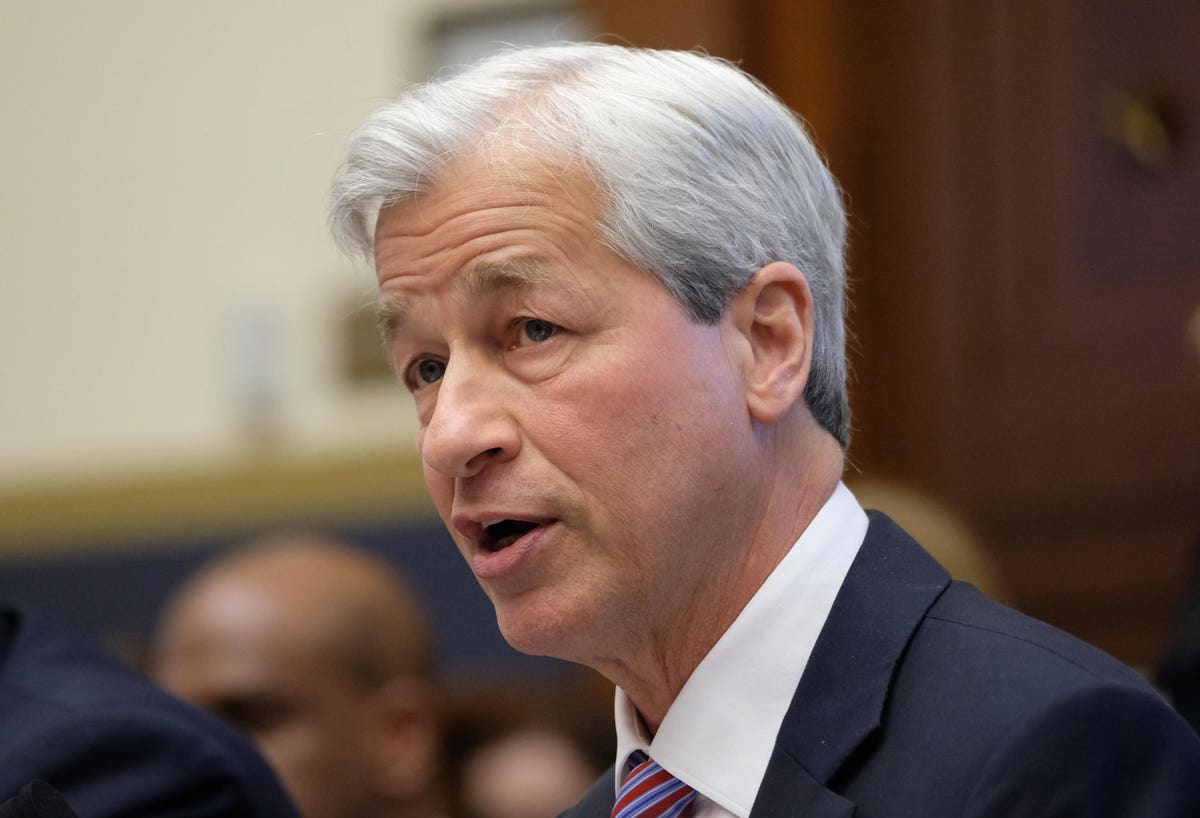This is the published version of Forbes‘ Future of Work newsletter, which offers the latest news for chief human resources officers and other talent managers on disruptive technologies, managing the workforce and trends in the remote work debate. Click here to get it delivered to your inbox every Friday!
JPMorgan Chase CEO Jamie Dimon drew headlines this week with his statement, in a Bloomberg television interview, that artificial intelligence could allow the next generation of workers to only work 3.5 days a week. It’s worth noting that this much-covered prognostication, if you watch the actual interview, seemed less a bold, go-out-on-a-limb prediction from Dimon than just one part of a long list of ways he thinks AI could have upsides in addition to downsides. Technology has long replaced jobs, he argued—but it’s done much good, too.
Whether or not AI is what ultimately gets us to that Keynesian prediction of only working 15 hours a week—less, of course, than Dimon’s predicted 28—it’s interesting to consider how AI may finally trigger more adoption of the four-day week that many have been pushing for recently. The UAW, after all, has a four-day week among its list of demands as it continues its historic strike against the Big Three automakers. Add the technological capabilities of AI to such mainstream conversation about what was once a fringe idea, and it might be adopted in more places more quickly than we think.
Want some ideas for what works and what doesn’t with a four-day week? Check out our contributors’ advice here and here. We’ve also chronicled the results of studies about how four-day work week experiments have been going (hint: pretty well). Whatever the catalyst—AI or employee demands—it will be interesting to watch how many more organizations actually try to shorten the five-day grind.
Hope it’s a great weekend, everyone.
Jena McGregor
Senior Editor, Future of Work, Careers and Leadership Strategy
POLICY & PRACTICE
After a three-year pause on student loan repayments, millions of Americans are once again facing college debt bills as repayments resumed on Oct. 1—an event experts say could prompt employers to step up with more relief, combined with new legislation and growing demand from workers for more help after years of escalating costs. My colleague Emmy Lucas has an insightful look at the legislative and other causes that could finally get employers more on board to help.
ARTIFICIAL INTELLIGENCE
Several work-related platforms added new AI capabilities this week. LinkedIn said Tuesday it was releasing new AI tools for recruiting and chatbots for career coaching, as well as predicting a 65% shift in job skills by 2030 due to AI. Meanwhile, work management software Asana announced new AI capabilities for increasing productivity and innovation.
HUMAN CAPITAL
Amid significant job cuts and tech-driven disruption, data from Hired found that demand for job postings on its platform dropped over the past four years, and that tech salaries, when adjusting for inflation, decreased 9% from $141,000 to $129,000 between 2022 to mid-2023, the lowest level in five years. Check out contributor Jack Kelly’s report on the study, as well as the latest from our layoff tracker.
In wage news, United Airline pilots won a 40% raise, as its union ratified a new contract amid a push from unions across U.S. industries to give workers higher pay and more protections. Meanwhile, a judge in New York ruled that Uber, DoorDash and Grubhub must pay $18 an hour to New York City delivery drivers, denying an attempt from the food delivery giants to block a city minimum wage law—aimed at helping regulate pay for gig workers—from going into effect. Finally, California fast food workers secured a $20 minimum wage—the highest in the U.S.—when Democratic California Gov. Gavin Newsom signed a new law Thursday raising pay from California’s current $15.50 rate.
The U.S. Equal Employment Opportunity Commission sued Tesla, one of billionaire Elon Musk’s companies, late last week, alleging the company has allowed “widespread and ongoing racial harassment of its Black employees” and retaliated against workers who opposed it for nearly a decade, the suit alleges. Forbes’ Molly Bohannon reported that Forbes has reached out to Tesla for comment; the Wall Street Journal reported that Tesla has said it “strongly opposes all forms of discrimination and harassment” and that it has a track record of disciplining and terminating employees who engage in misconduct.
What’s Next: Tome Cofounder And CEO Keith Peiris
I spoke recently with Keith Peiris, the cofounder and CEO of Tome, an AI storytelling startup that Forbes reported in February passed a million users 134 days after launch—one of the fastest productivity tools to reach that number (Peiris shared even bigger numbers below). We chatted about how AI natives approach work differently, what business is looking for with AI and the future of that most universal of work tools, the slide deck. Excerpts from our conversation below have been lightly edited for length and clarity.
Tell us a little about Tome?
We [Tome’s cofounders] came from a consumer social world; we all worked on different kinds of communication products. So a lot of our thinking was around ‘Hey, when you look at what Instagram or Snap did to make real world storytelling powerful, expressive and simple through the smartphone, can we do the same thing with ideas and concepts in your head?’ For us, the technology that made that possible was foundation [large language] models to help you find narrative, find structure, to shape what you’re saying. To me, that was very analogous to a camera that’s connected to a 5G network in your pocket.
We decided to just launch it like a consumer product to see what would happen. There’s been a lot of demand. We went from 0 to 10 million users in less than nine months, and it continues to grow. Through that, we’re actually finding there is a different style of work emerging in Tome.
What do you mean by that?
I’ll start by saying it’s a little generational. A big chunk of our users—I think almost 30%—you would classify as Gen Z. They haven’t been trained on PowerPoint for 25 years. So I think they’re open-minded on [what’s] the right way to work.
In the old world, you used to show up to Google Slides or PowerPoint with a very succinct summary of what you wanted to say. I already had this narrative in my head. I know what I want to put on each slide, and now I’m going to open this tool and type it out, drag things around and make it pretty. I call that the last mile of presentation building or storytelling. You’ve done all of the hard cognitive work already and now you go to this tool to manifest what’s in your head.
The biggest difference we see with AI native users is they’re showing up to our tool with considerably less. They’re showing up with, ‘I think I’ve got an idea of the way I want to write my pitch deck, but show me a couple of variations. Show me the eight-page version, the 12-page version, the Y Combinator version.’ They’re looking at it for brainstorming; for inspiration.
So AI is not just helping to speed up your work, or simplify, but it’s actually changing how people approach work.
It’s always more fun and more fruitful to collaborate with a thought partner. At Tome we have this rule that engineers always need to be working with one other engineer. The code quality is better. The thinking is better. Suddenly [with AI] we’re giving folks a thought partner that’s really fast, that’s awake 24/7, that you can just sort of give commands to, and it won’t get tired of you.
I’ve seen Tome described as like an AI-driven stand-in for PowerPoint. Is that fair?
I personally argue it’s a little too narrow. The reason I say that is I’m not sure the slide is going to make it. Over the next 30 years I’m not sure we’re all going to be looking at a 16×9 static rectangle. We’re working on phones. We’re working through Zoom. All of our data is live in the cloud. Our attention spans are shorter because of TikTok. I think the slide deck is on the decline. There are companies in Silicon Valley that refuse to even use [slide decks].
We’re taking a lot of PowerPoint use cases. Sales decks and pitch decks and all of that stuff. But we’re getting other stuff, too. People are making resumes in Tome, they’re building how-to guides. They’re writing documents. They’re doing a bunch of different things with Tome that I don’t think you would do that with slides.
FACTS AND COMMENT
Busting the “lazy girl” jobs chatter is the latest report on women in the workplace from LeanIn and McKinsey, Forbes’ Maggie McGrath reports. At every level of the corporate pipeline, the 9th annual report finds, women are as committed to their careers as their male counterparts, McGrath writes, even as men continue to dominate the highest levels of company leadership. The rules of ambition may be changing, and even showing up in quieter forms, new studies show, but women aren’t lacking it, the LeanIn/McKinsey report finds.
81%: The percentage of women who say they want to be promoted to a higher level this year, up from 70% in 2019.
28%: The representation of women in the C-suite, according to McKinsey and LeanIn, a higher level than ever before. Just 6% of leaders in the C-suite are women of color, however.
“Something got into the ethos suggesting” those who want to work remotely or flexibly are less motivated, McKinsey senior partner Alexis Krivkovich told Forbes. “Rather than flexible work being something that’s muting ambition, it’s actually unleashing it.”
VIDEO
The C-Suite Interview: Kickstarter CEO Everette Taylor
Watch
STRATEGIES + ADVICE
What you need to know about ‘talent density.’
A blueprint for overcoming digital burnout—and creating more digital wellness at work.
Take stock: Here’s what your CEO is most concerned about today.
QUIZ
USA Today publisher Gannett posted a new kind of media job: The colossal pop star beat, for a reporter who will cover Taylor Swift and Beyonce full-time, with the job posting prompting a social media event of its own. As of Sept. 28, Forbes reported approximately how many people had applied to the job?
- More than 500
- Nearly 1,000
- Just over 2,500
- Roughly 5,000
See the right answer here.
ACROSS THE NEWSROOM
- Get our weekly rundown on the future of climate tech with our Current Climate newsletter. Sign-up here to get tomorrow’s edition.
Thanks for reading! Follow us on Twitter for by-the-minute updates on the latest business and financial news throughout the day.
Read the full article here





